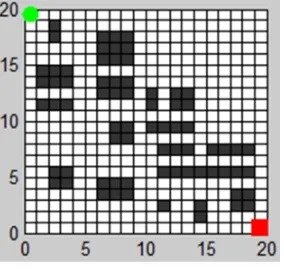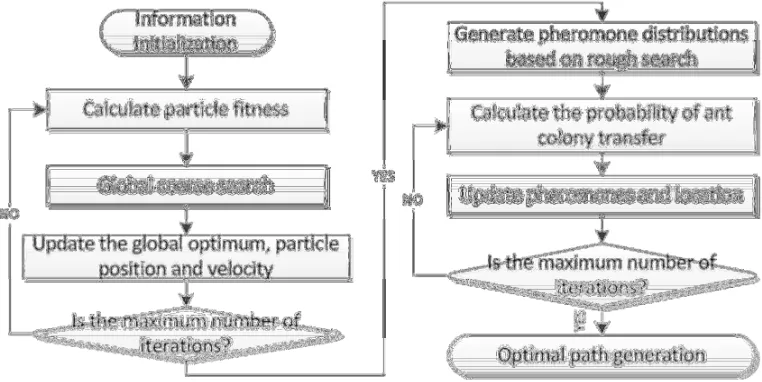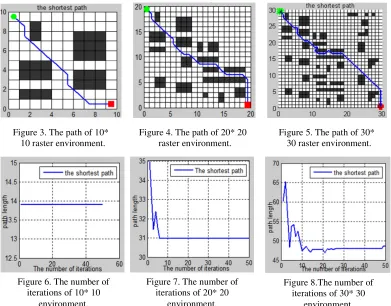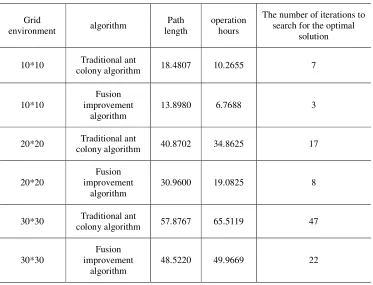2017 International Conference on Electronic and Information Technology (ICEIT 2017) ISBN: 978-1-60595-526-1
Application of Ant Colony-Particle Swarm Optimization
Algorithms in Path Planning of Security Robots
Jin-zhi REN
1and Wei XIANG
a,*College of Electrical and Information Engineering, Southwest Minzu University Chengdu, Sichuan, 610041, P, R. China
awei.xiang@foxmail.com
*Corresponding author
Keywords: Grid obstacle models, Integrated ant colony-particle algorithm, Optimal path, Security robot
Abstract. In order to improve the efficiency in path planning of security robot, this paper addresses to construct three kinds of grid obstacle models from simple to complicated, and use the integrated ant colony-particle algorithm to make global path planning. For further explaining the effectiveness of the combined algorithm implementation, this paper compares the different effects in path planning of the traditional ant colony algorithm and the combined ant colony-particle swarm optimization from three aspects, which are the iteration number of searching the optimal solution, the shortest path length and the running time. It is found that the integrated ant colony-particle algorithm enhances the search efficiency of the optimal solution and reduces the number of iterations of the search, so as to complete the optimal path of the security robot from the start point to the end point.
Introduction
Modeling of the Ranch Monitoring Robot’s Working Environment
The actual working environment of a mobile robot is a realistic physical space, and the space handled by the path planning algorithm is an abstract space of the environment. Environment modeling is a very important link of the robot path planning. Through a large number of literature research [4], this paper uses the grid method to establish the model. The working environment is divided with grids of the same size and the obstacle model is constructed according to the working environment of the security robot.
Regardless of the information of the robot in the height direction, a limited number of static obstacles are provided in the two-dimensional space of the robot. Let the horizontal axis be the x-direction and the vertical axis be the y-direction. Let the walking distance of the robot be a. Divide the x- and y-axes equally at a-step to form grids. The number of grids per row isNx X /a
max
= , and the number of grids per
column isNy Y /a
max
= .
[image:2.612.237.379.304.440.2]Take a medium-difficulty raster model as an example, and take Xmax = Ymax = 20 and a = 1. That is, using a global static 20 * 20 grid matrix, the black grid represents the obstacle area and the other grids represent the free space, as shown in Figure 1.
Figure 1. 20 * 20 robot working environment modeling.
In the grid model shown in Figure 1, the grid coordinates can be obtained from the grid number i:
+ −
=
+ − =
5 . 0 ) 20 / ) 1 ((
5 . 0 ) 20 , 1 mod(
i fix y
i x
(1)
Among them, mod is the complementary operations and fix is the rounding operation.
Integrated Ant Colony and Particle Algorithms
The Traditional Ant Colony Algorithm Principle
LetPijk(t)denote the probability of ant k going from point i to next point j. When the
ant passes through all the points, the pheromone stored in the environment will be updated [5]. When all the ants complete their own path construction, the pheromone on each path gradually increases, and the calculated pheromone concentration is recorded asτij(t). When the concentration meets the termination condition (ie when
∈ =
∑
∈ otherwise allowed j t t t t t P k allowed s is is ij ij k ij k 0 ) ( ) ( ) ( ) ( )( α β
β α η τ η τ (2) ∆ = ∆ ∆ + − = +
∑
() ) ( ) ( ) ( ) 1 ( ) 1 ( t t t t t k ij ij ij ij ij τ τ τ τ ρ τ (3) Among them:In Eq. (2),
η
ijβ(t)is the heuristic factor, and ijβ(t)=1/dijη
; dij is the distancebetween points i and j;τij(t)is the pheromone concentration on the path at time t
between points i and j;allowedkis the point set the ant can choose at time t; α,β are respectively the relative importance of τ, . η
In equation (3), ∆τij(t)is the pheromone increment between node i and j.
Particle Swarm Algorithm Theory
The initial state of particle swarm optimization algorithm is a group of particles randomly distributed in the solution interval, constantly updating the position and velocity of the particles, constantly comparing to obtain the optimal or suboptimal solution and achieve path planning [6]. Particle swarm formula is as follows:
+ + = + − + − + = + ) 1 ( ) ( ) 1 ( )) ( ()( )) ( ()( ) ( ) 1 ( 2 , 1 t V t X t X w t X g rand C t X P rand C t wV t V ij ij ij ij best ij best ij ij ij (4) ) (t
Vij and Xij(t)are the current velocity and position of the particle respectively;
2 1,C
C are learning factors;
best ij
P
, is the individual extreme value of the current (i, j) the particle search; and gbestis the global value.
Integrated Ant Colony and Particle Algorithms
As ant colony algorithm and particle algorithm have their own advantages and disadvantages, this paper combines the two algorithms for path planning. The ant colony algorithm searches for the optimal path through positive feedback and distributed collaboration, which can search globally and parallelize. However, the slow convergence speed, the long computing time and the irrational parameter setting will put the entire path in disorder. Particle algorithm can just make up for the shortcomings of the ant colony algorithm with the advantages of good search performance, fast convergence. Therefore, the path of security robot can be optimized by particle algorithm to achieve a rough search to get enough pheromones on the path, and then search accurately by the positive feedback feature of ant colony algorithm. The Integrated ant colony and particle algorithm is shown in Figure 2.
The steps of the ant colony and particle algorithm integration can be summarized as a few steps:
1) Initialize each parameter.
3) When the number of iterations reaches the initial value, the pheromone is updated based on the rough search to improve the search ability of the ant colony algorithm.
[image:4.612.115.496.142.333.2]4) Use the ant colony algorithm mode for fine search, and ultimately get the optimal solution.
Figure 2. Diagram of integrated ant colony and particle algorithms.
Application of Integrated Ant Colony and Particle Algorithms on Robot Simulation
In order to show the effectiveness of the combined ant colony and particle algorithm in security robots, a global path planning of the pasture monitoring robots under a convergent algorithm is constructed. By using matlab simulation, grids of 10*10, 20*20 and 30*30 Map are established to identify the obstacles. The 10*10 grid map shows the simple-obstacle environment, 20*20 grid maps shows the middle-obstacle environment, and 30*30 grid map shows the difficult-obstacle environment. Starting point is in the upper left corner (green) and the ending point is in the lower right corner (red). Algorithm initialization: the number of ants per wave is 30, Alpha = 1, Beta = 15, pheromone is 0.95, and the number of iterations is 100 times. The simulation results are as follows:
①Simulation experiments are carried out in a 10*10 grid environment. The path planning is shown in Figure 3, and the path planning length is 13.89800. The convergence curve is shown in Figure 4.
②In 20*20 grid environment, the path planning is shown in Figure 5, and the path planning length is 30.96000. The convergence curve is shown in Figure 6.
In order to further illustrate the efficiency of the combined ant colony and particle algorithm, Table 1 compares the effects in path planning of traditional ant colony algorithm and the integrated ant colony-particle from the three aspects which are the search optimal solution iteration number, the shortest path length and the running time. The initial conditions and the original environment of the three obstacles remaining unchanged, the average is calculated after 50-time tests.
[image:5.612.110.501.65.371.2]As shown in Table 1, the integrated ant colony-particle algorithm reduces the run time by 24.79% and shortens the path length by about 24% in a 10 × 10 grid environment. In a 20 × 20 grid environment, the combined ant colony-particle algorithm reduced the run time by 45.26% and shortened the path length by 24.24%. In the 30 × 30 grid environment, the combined ant colony-particle algorithm reduced the run time by 23.73% and shortened the path length of 16.16%. Moreover, the more complex the obstacle environment, the more the number of iterations of searching for the optimal solution decreases. The results show that the integrated ant colony-particle algorithm is more effective in the safety robot path planning.
Figure 3. The path of 10* 10 raster environment.
Figure 4. The path of 20* 20 raster environment.
Figure 5. The path of 30* 30 raster environment.
Figure 6. The number of
iterations of 10* 10 environment.
Figure 7. The number of iterations of 20* 20
environment.
Figure 8.The number of iterations of 30* 30
Table 1. Comparison between improved or traditional algorithm.
Grid
environment algorithm
Path length
operation hours
The number of iterations to search for the optimal
solution
10*10 Traditional ant
colony algorithm 18.4807 10.2655 7
10*10
Fusion improvement
algorithm
13.8980 6.7688 3
20*20 Traditional ant
colony algorithm 40.8702 34.8625 17
20*20
Fusion improvement
algorithm
30.9600 19.0825 8
30*30 Traditional ant
colony algorithm 57.8767 65.5119 47
30*30
Fusion improvement
algorithm
48.5220 49.9669 22
Conclusion
In order to solve the problem of path planning for security robots, this paper proposes an integrated ant colony + particle algorithm for robot applications. Using matlab to simulate the three kinds of obstacle environments from simple to complex, the path planning is made through integrated algorithm in three environments. In order to verify the validity of the combined ant colony-particle algorithm, this paper takes the test 50 times in each environment without modifying the initial conditions and record the running time, the shortest path length and the number of iterations by searching for the optimal solution of the traditional ant colony algorithm and the integrated ant colony-particle swarm optimization algorithm. In this paper, we find that the integrated ant colony-particle algorithm improves the search efficiency of searching for the optimal solution and reduces the number of iterations of the search, so as to complete the optimal path of the robot from start to end.
Acknowledgement
This work was partially supported by Sichuan Youth Science and Technology Innovation Research Team (2017TD0028).Also was supported by the Fundamental Research Funds for Central University, Southwest Minzu University (2017NZYQN45)
Reference
[2] Chunming Ren, Jianxun Zhang. The Path Planning for Robot Based on Optimized Ant Colony Algorithm [D] Computer Engineering, 2008, 32-35.
[3] Tianyu Yang,Yang Xue, Yafei Zhang. Path Planning of Inspection Robots Based on Ant Colony-Particle Swarm Optimization [D] Modern Computer, 2017, 48-50
[4] Fang Gao. Intelligent particle swarm optimization algorithm [J], Harbin Institute of Technology, 2008, 27-31
[5] Xingcheng Pu, Junjie Li, Huichao Wu. Multiobjective Point Path Planning for Mobile Robot Based on Improved Particle Swarm Optimization [J]. Journal of Intelligent Systems, 2017, 302-306.



